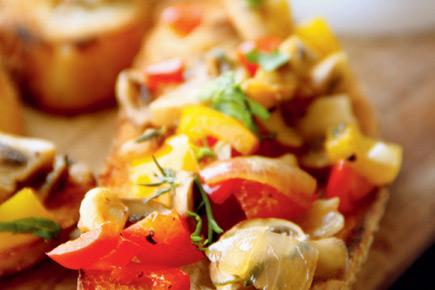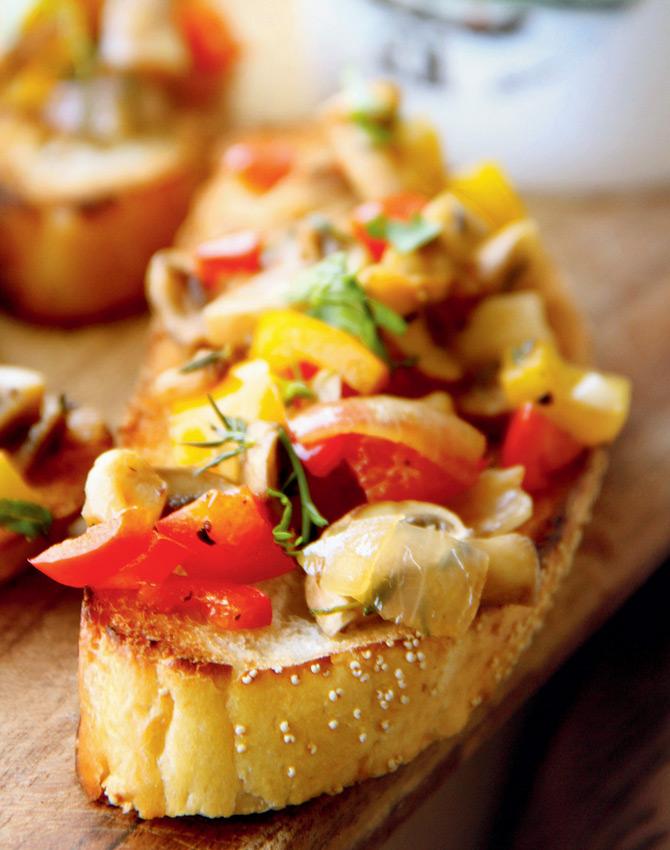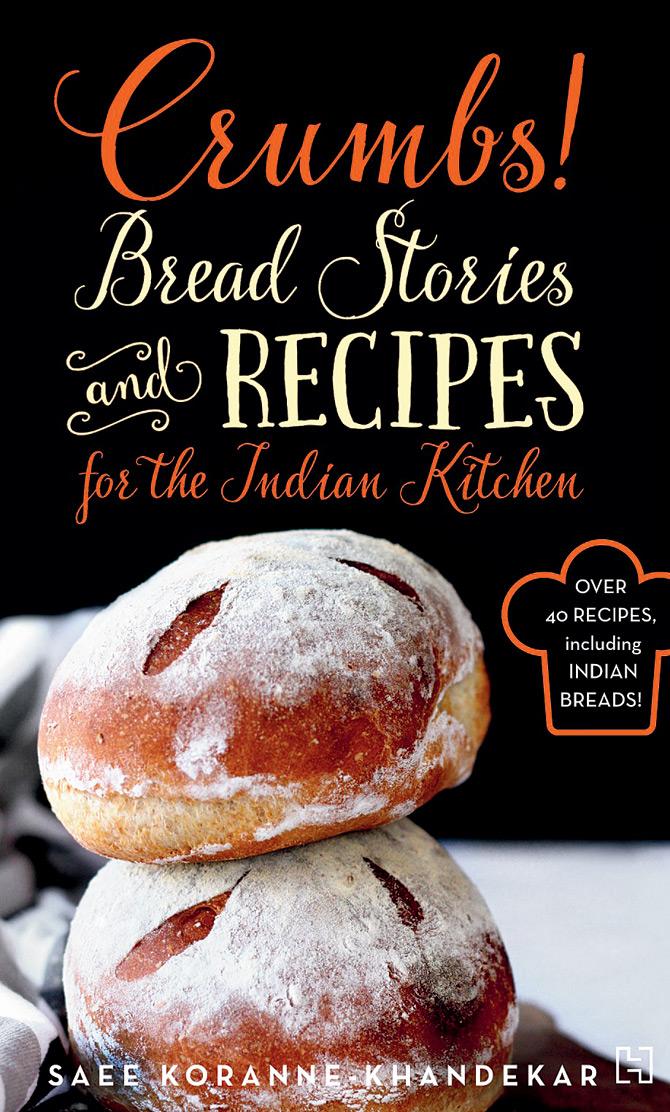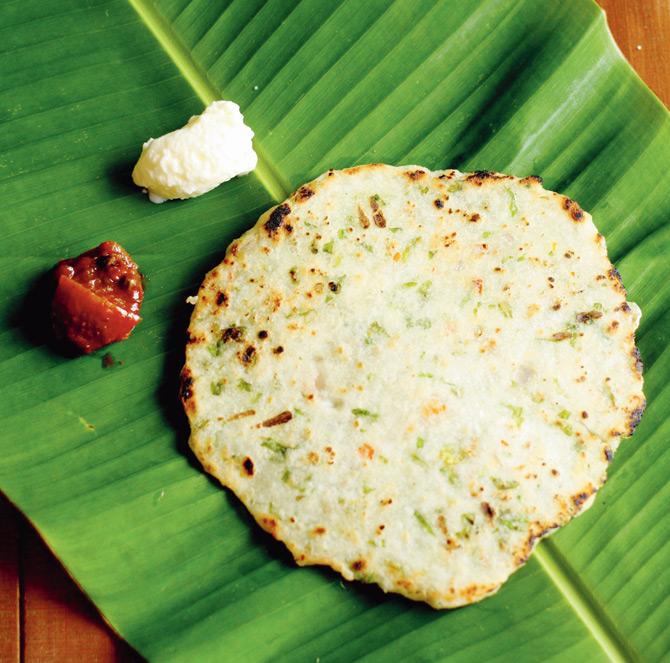From French Fougasse to East Indian Fugiyas, you can learn to bake over 40 breads with food writer Saee Koranne-Khandekar, who will help yeast-fearing home cooks master the art in her debut book, Crumbs!

Use leftover breads to make bruschetta
![]()
ADVERTISEMENT
A childhood memory that Thane-based food writer Saee Koranne-Khandekar cherishes till date is sitting atop a tall stool in her maternal grandmother’s kitchen, filled with awe as she watched her roll out silken, soft Maharashtrian-style poli (layered chapatis) and roast bhakri on an iron tava. "The bhakri would puff up on a naked flame. She would immediately slather it with fresh, homemade white butter and my brother and I would devour it instantly," says Khandekar, who has added the traditional recipe, to more than 40 Indian and international breads, in her book, Crumbs! Bread Stories And Recipes For The Indian Kitchen, which releases today.

Use leftover breads to make bruschetta. Pics Courtesy/Saee Koranne-Khandekar
"Bread-making at home is still new to most Indians. Those who have dabbled in it have struggled with commercial yeasts, flours, etc. I also realised that international books on bread asked for ingredients that are not easily available here. For instance, what is strong white stone ground bread flour?
We only know of maida and atta. So, Crumbs! was envisioned as a book that demystified bread-making in the Indian context," says Khandekar, who learnt to make breads as part of a certificate course in Bakery and Confectionery, that she took up alongside a junior Arts programme (and later, also completed Masters in English Literature). A decade ago, after working in publishing and e-learning fields for some time, she started her food blog and turned it into a vocation, establishing Scrollific Content Studio, a content and consultancy agency exclusively for the food and hospitality industry.

Food writer Saee Koranne-Khandekar
In her dough main
From the history of breads to their transformation over the years, understanding different varieties, along with the tools and flours needed to make them, climatic challenges, and a troubleshooting section too, the book features the A to Z of bread-making. It also includes step-by-step illustrations of complex recipes and quirky sketches of bakeries like Theobroma and The Baker’s Dozen. Khandekar explains the research process, "I revisited my college journal. I also invested in books on bread-making (Indian and international), ate all sorts of bread and tried to recreate these in my kitchen, making notes with every change. At one point, I was looking at chemical equations that explained the science of bread!" The writer has also included insights from bakers, boulangerie owners, paratha galli owners and cooks, who she met during the making of the book.
From pizza to poee
A large part of the book is dedicated to recipes including basics like Dinner Rolls, White Sandwich Loaf and pizza base, international varieties like the French Brioche and Baguettes, the Jewish classic Challah and Italian Fougasse and Grissini breadsticks. "It took me a while to get the croissants and sourdough bread right. When I attempted a croissant, the butter would always melt in the Mumbai weather.
For sourdough, I kept following recipes meant for colder climates, so I would invariably wait too long and by then, it was too late," recalls Khandekar, who twea-ked the recipes to suit local conditions and Indian ovens.
She has incorporated her own recipes, such as that of artisanal Gluten-Free bread, which she tried "a zillion times and was about to give up when good old sabudana (sago) came to the rescue." The book also features Indian varieties like Laadi Pao, Fugiyas, Sheermal, Akki Roti, Thaalipeeth and Poee. Shaped from her childhood memories, many of the traditional recipes appear with alternative flavouring suggestions too.
"Once, I ran out of garlic to make naan with and discovered the Maharashtri-an-style Lasun chutney (garlic and dried coconut) in the pantry. I happily stuffed the naan with it and slathered it with salted butter. Since then, my family prefers this version," says the mother of three, who enjoys pao with omelette and brun with her chai, "luxuries I enjoy when my children are not bringing the house down."
Tips for the Breadmaker

Crumbs! Bread Stories and Recipes For The Indian Kitchen, Saee Koranne-Khandekar, Hachette India, Rs 450, available at bookstores and e-stores
>> Always ensure your yeast is fresh and alive.
>> Use the best-quality flour (even local) that you can find.
>> Be patient.
Akki Roti

Akki Roti, an Indian bread made using rice flour in parts of Karnataka.
Ingredients:
· 180 grams rice flour
· 1 green chili, made into a coarse paste in a mortar and pestle
· 2 tablespoons finely chopped dill or fresh green coriander leaves
· 1 small red onion, finely chopped or ½ a small cucumber, peeled and grated (skip this if using dill)
· 1/2 teaspoon cumin seeds, bruised
· A pinch of asafetida
· Salt to taste
· 60 milliliters water (more or less as required)
· 45 milliliters vegetable oil
Method:
i. Combine all ingredients (except the oil) in a large mixing bowl and knead to achieve a soft dough using as much water as required. You will need lesser if you use onions or cucumbers and a little more if you use just the greens.
ii. Divide the dough into 4 balls.
iii. Grease an iron griddle or tava with a few drops of oil. Place one ball in the center of the tava and flatten using your fingers to about ¼ inch thickness. Place the tava on medium heat and cook on both sides until brown spots appear.
iv. To make subsequent akki rotis, place a sheet of thick plastic or cling wrap on a work surface and grease it lightly with a few drops of oil. Use this surface to pat the rest of the akki rotis and transfer to the waiting tava. Alternatively, you could use a moist square of muslin to pat the akki roti on; this is easier to transport to the tava without burning.
v. Serve hot with chutneys.
 Subscribe today by clicking the link and stay updated with the latest news!" Click here!
Subscribe today by clicking the link and stay updated with the latest news!" Click here!






